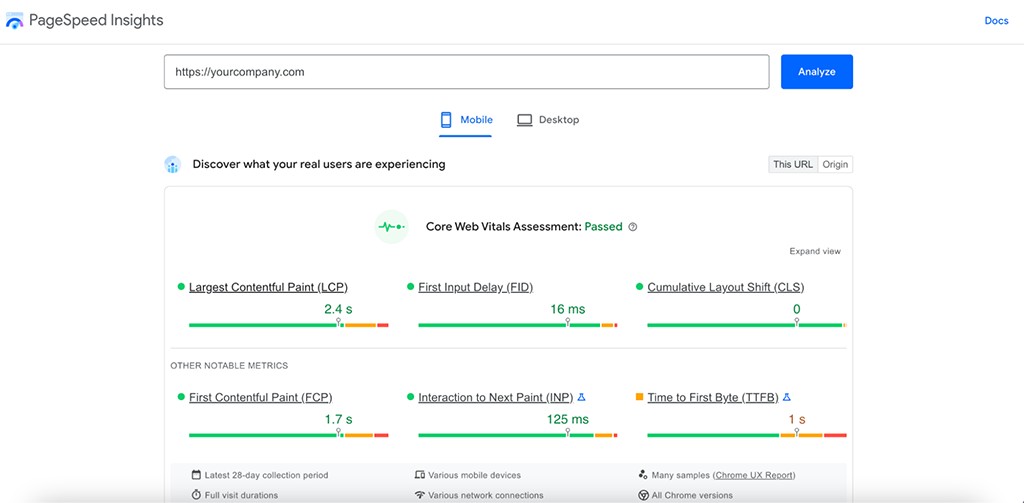5 SEO lead generation tips to implement
SEO stands for search engine optimization and refers to the steps taken to improve your site’s performance to rank in search engine result pages (SERPs). An effective SEO strategy can be a powerful lead generation tool that allows you to attract a pool of potential customers searching for your product or service—without dipping into your digital advertising budget.

SEO lead generation can be a lucrative yet highly competitive digital marketing channel. According to a research report by Backlinko, the number one search result gains over a fourth (27%) of search traffic, and is 10 times more likely to be clicked than the 10th result, even though both are on the first page.
Fortunately, there are effective strategies to help your business’s website rank higher—and they don’t require hiring a pricey SEO services agency. Discover practical SEO lead generation tips that business owners can implement today to attract more customers.
SEO lead generation isn’t just about keywords
Your rank in search engine results doesn’t just stem from the number of keywords typed onto a web page. Search engines award top slots to sites delivering a positive user experience. If you’ve switched up your content marketing strategy but don’t see more traffic, it could be due to your web design or another technical issue. Slow site speed, a poor site map, or underperforming Core Web Vitals will penalize you within search results.
- Slow site speed: A slow site speed could stem from large media files (videos, full resolution images, or GIFs), too many plugins or custom fonts, or unused CSS. Visit pagespeed.web.dev to view performance reports for the mobile and desktop versions of your site and see suggestions for improving your site speed.

- Poor sitemap: Your sitemap (a file on all elements of your website and relationships between them) should be clean, easy to navigate, and be submitted to the Google Search Console. Be sure to link to your blog from your homepage, within your top navigation or footer.
- Underperforming Core Web Vitals: Your Core Web Vitals is a report showing performance over three primary metrics (largest contentful paint, first input delay, and Cumulative Layout Shift) that allow developers to understand how website visitors experience your page. You can run your report here to determine how these three factors result in a positive user experience.
Create an SEO lead generation strategy with these 5 tips
Ranking higher in search engine results starts with optimizing your website’s existing content and producing new, keyword-focused content. To improve your chances of reaching high-quality leads, start with these SEO tips.
1. Never sacrifice good copy for SEO
When marketers first realized they could leverage search engines to attract new leads, some defaulted to a shortcut called keyword stuffing. Many content marketers offering SEO services crammed as many targeted keywords onto a single web page in an attempt to “beat” search engine algorithms.
The result? Brands published overly-written content with dozens of search terms crammed into a single page—at a detriment to readers. Like most shortcuts, keyword stuffing has proven to be ineffective. Not only can you get penalized for keyword-stuffing and other spammy content, but you could see a spike in bounce rates (website visitors arriving on a page and immediately exiting) and a decline in conversion rates (visitors who take a desired action, like signing up for your email list or making a purchase).
2. Create a blog calendar

Most SEO content strategies should take place on your company blog for two reasons:
- A blog consists of long-form content, giving you 1,200 words (or more) to write your targeted phrase eight or more times without keyword stuffing. (A landing page, by contrast, may only contain 300-600 words, making on-page SEO difficult.)
- Your blog is housed on your own website, thereby helping to build domain authority (more on this below). Sometimes, marketers put a great deal of energy into producing social media or email marketing content, even though that content is housed elsewhere (e.g., Instagram captions, LinkedIn posts, or TikTok videos).
Aim for a cadence of posting at least once per week to alert search engines you’re posting regular, high-quality content. When selecting topics, strike a balance between 1) directly-related keywords gaining high-volume traffic with high competition and 2) related search queries with low volume and low competition. For example, if you own a car wash business you might write posts about more obvious topics (e.g., “car washes near me”) and other related topics (e.g., “how to preserve your car’s paint job”).
3. Develop a keyword research strategy for your target audience
Understanding your target market is a key element of SEO lead generation. It can help you determine the search intent of your potential customers and identify keyword phrases to pursue. You can do this through several ways:
- Use a keyword research tool to discover new keywords to help reach your target audience. Using this type of SEO tool can help you create a spreadsheet of relevant keyword phrases for your company, with estimated search traffic and competition for each.
- Enter a phrase you’re considering directly into a search engine. Scroll to the bottom of the search results and see various phrases for your query.
- Following the same approach for step two, pay attention to related questions to your query. Consider using these questions for headers within your own blog post.
4. Tweak your publishing cadence

Landing at the top of SERPs requires a high domain authority, which essentially tells search engines that you’re a trusted industry expert on a given topic.
If your marketing strategy includes blog content, but your traffic hasn’t budged, you may need to increase your posting frequency. Building up a library of content will help search engines view you as a trustworthy resource, and increasing your publishing cadence for at least several weeks will allow you to compare traffic results and determine the most effective and sustainable cadence for your business.
5. Invest in a link building strategy
Backlinks are links from other sites that drive organic traffic (non-paid) toward your website. To increase your domain authority, build partnerships with trusted external sites to develop these links.
Part of launching an SEO campaign includes getting backlinks from a number of sources, including:
- A high-quality piece of content: Investing in well-written content pays dividends when other websites cite you as a resource. Publish original research, like a survey or study, then submit it to a service like PRNewswire to gain external citations.
- Your PR strategy: Landing features in podcasts, news articles, and blog posts helps drive traffic to your site. Subscribe to a service like HARO (Help a Reporter Out) or Qwoted to connect with reporters searching for credible sources in your industry.
- Your local SEO strategy: Search results will favor businesses that are in close proximity to the individual typing the search query. Create a local SEO checklist and add or claim your Yelp Business Page to attract local traffic and gain a backlink to your website.
- Repairing broken links: If you recently went through a website redesign project or you simply have old web pages, your site could contain broken links. Set up a permanent redirect on your hosting platform to guide searchers toward the intended page and avoid losing the traffic to your site.
Get found for free
Show up for any of the millions of customers on Yelp searching for a business like yours.

Implement your SEO lead generation efforts to drive better results
SEO-focused content attracts leads at the top of the sales funnel. It can be a powerful B2C and B2B lead generation tool as potential customers actively search for your product or service.
With the right tools, keyword research, and content strategy, business owners like you can improve site rankings without having to hire an SEO agency. It can take months to a full year to see an increase in organic traffic, which is why many business owners pair SEO with paid advertising. Learn how to write effective copy for your first advertisement to inspire your future campaigns.